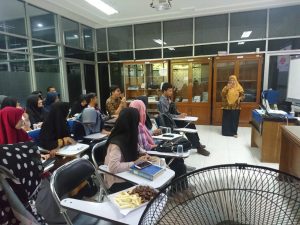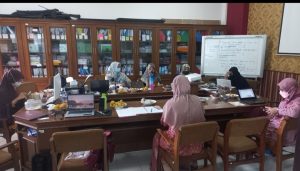The occurrence of resistance of pathogenic bacteria to existing antibiotics encourages research to find new sources of antibiotics. The phenomenon of the occurrence of this resistance occurs all over the world. Even the latest data for 2019 shows more than 2.8 million infections are resistant to antibiotics in the United States each year and cause more than 35,000 people to die.
Currently, many researchers are focusing on studying Streptomyces, which is known as a bacterium that is able to produce the most antibiotics (75-80%). One of them is Ambarwati who is one of the teaching staff at the Public Health Study Program, Faculty of Health, University of Muhammadiyah Surakarta. In her dissertation entitled “Molecular Characterization and Bioactive Compounds of Streptomyces from the Rhizosphere of Teki Grass (Cyperus rotundus L.) in the Cemoro Sewu Highlands, Magetan, East Java”, Ambarwati succeeded in discovering a new Streptomyces species whose name was proposed as Streptomyces cemorosewuensis sp. Nov. Currently, the Whole Genome Sequencing (WGS) sequence of the new species is in the process of being submitted to the NCBI (National Center for Biotechnology Information) to obtain an accession number.
“In this study I found six Streptomyces isolates that have the potential to produce antibiotics.” Ambarwati said “Actually, based on the phylogenetic tree analysis based on the 16S rRNA gene sequence, there are two isolates that have the potential to become new species, namely isolates CRB41 and CRB47. Both have similarity index with comparison species of 94% and 85%. This index is below the standard for determining one species, which is 98.65%.” he continued. “However, because the isolate CRB46 is the isolate that has the most potential to produce broad-spectrum antibiotics and is even capable of acting as an anticandida, this isolate was chosen for further analysis with WGS, even though the similarity index of the 16S rRNA gene was 100%.” Ambarwati explained further.
However, this result is actually able to change the basic concept that has been widely used by researchers around the world. “So far, researchers have only determined the status of new species based on the similarity of the 16S rRNA gene, but these results show that two isolates with a 100% 16S rRNA gene similarity index turned out to be only 95.31% similar after being in WGS. That is, if based on the 16S rRNA gene sequence both are one species but with WGS both can be said to be different species.” Ambarwati said.
However, this claim as a new species is not based solely on the difference in the WGS sequence similarity index. To support our conclusion that the isolate CRB46 is a new species, we performed an analysis with three software, namely RASH, AntiSMASH and BASys. The results of the analysis of the three software showed significant differences between the isolate CRB46 and the comparison species, namely Streptomyces rochei NRRL B2410.
“Honestly, my previous dissertation research path was not like this. My last promoter, Prof. Ir. Triwibowo Yuwono, PhD from the Faculty of Agriculture UGM, actually suggested WGS. So that this new species can be found.” Said the mother of three children. “Therefore, on this occasion I would like to thank Prof. Ir. Triwibowo Yuwono, PhD and also my co-promoter Prof. Dr. Subagus Wahyuono, MSc, Apt (Faculty of Pharmacy UGM) and Prof. Sukarti Moeljopawiro, PhD (Faculty of Biology UGM) who has supported the change in the direction of my research and the three of them have wholeheartedly and willingly taken the time to guide me. The three of them had wanted to “run when I had to run because I was being chased by the January 2020 deadline I had to pass.” Obviously this woman who is usually called Ambar is more advanced. “‘May Allah be pleased to record the goodness of the three of them as charity and useful knowledge which God willing, the reward will flow until the end of time, Amen,” continued Ambarwati. He also explained that research using the WGS approach in Indonesia is still relatively rare due to the relatively high cost.
Advances in molecular biology with the success of WGS combined with advances in bioinformatics with computers (Genome Mining) have been able to predict gene clusters that play a role in the production of bioactive compounds. Based on the results of the AntiSMASH analysis, it is known that S. cemorosewuensis sp. Nov has 53 clusters of genes encoding bioactive compounds.
The interesting thing about the 53 gene clusters is that it is indicated that S. cemorosewuensis sp. Nov produces geosmin and malasidin compounds. Based on the results of previous studies, geosmin is known as an active chemical compound even in very small concentrations, namely 5 ppm. Meanwhile, malasidin (a nucleoside group) is a new type of antibiotic with extraordinary activity due to its ability to inhibit pathogenic Gram-positive bacteria that have become resistant to antibiotics (multidrug-resistant pathogens), and can cure skin infections caused by Staphylococcus aureus that is resistant to methylisin (MRSA). ) by damaging the bacterial cell wall.
Ambarwati has successfully defended her dissertation at the closed examination session of the Faculty of Biology UGM on January 20, 2020. The trial was led by the head of the Doctoral Study Program of the Faculty of Biology, Dr. R.C. Hidayat Soesilohadi, MS with the composition of the examiner team: Prof. Dr. L. Hartanto Nugroho, MAgr, and Dr. Endah Retnaningrum, MEng, both from the Faculty of Biology UGM, Dr. rer. Nat. Nanang Fakhrudin, MSi, Apt from the Faculty of Pharmacy UGM and Prof. Dr. Hj. Hermin Pancasakti Kusumaningrum, MSi, as an external examiner from UNDIP.
“Actually, there is one thing I want to convey to the public through this paper. Allah is just, He created things in pairs, there is day and night, there is a male and a female. Likewise, Allah created bacteria that cause infectious diseases on the one hand, and on the other hand Allah also created bacteria that produce antibiotics, especially Streptomyces.” Ambarwati’s message. “I am very, very grateful that after going through such a winding road, God finally allowed me to finish my studies at the Doctoral Study Program, Faculty of Biology, UGM. And even only with Rahmad and Allah’s blessing, if I can get the maximum score. This is certainly something I must be grateful for with my family.” Ambarwati continued.
“On this occasion I would also like to thank UMS and the Public Health Study Program who have supported my studies, as well as to my husband and children who have sacrificed a lot during my studies.” Said Ambarwati, “In addition to that, Ms. Dian Widyastuti, Dik Tri Handayani, Dik Hadid, Dik Ratri and Mas Fauzi who have assisted my research at UMS, as well as Mbak Tri Purwanti and Mas Miftah who have assisted in molecular biology research and analyzed WGS results, including all those who have helped that I cannot mention one by one, may Allah record it as a good deed. amen.” Say ambarwati as a closing word.





